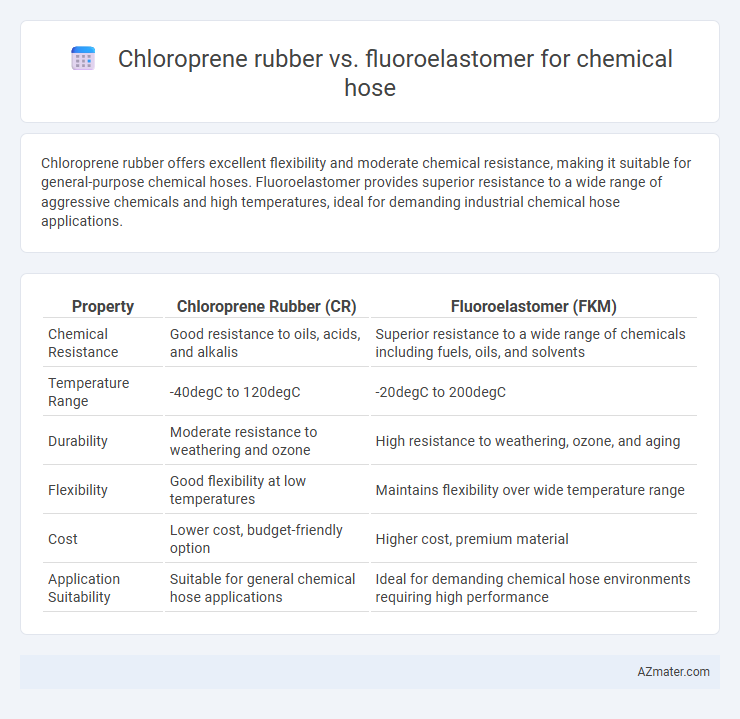Chloroprene rubber offers excellent flexibility and moderate chemical resistance, making it suitable for general-purpose chemical hoses. Fluoroelastomer provides superior resistance to a wide range of aggressive chemicals and high temperatures, ideal for demanding industrial chemical hose applications.
Table of Comparison
| Property | Chloroprene Rubber (CR) | Fluoroelastomer (FKM) |
|---|---|---|
| Chemical Resistance | Good resistance to oils, acids, and alkalis | Superior resistance to a wide range of chemicals including fuels, oils, and solvents |
| Temperature Range | -40degC to 120degC | -20degC to 200degC |
| Durability | Moderate resistance to weathering and ozone | High resistance to weathering, ozone, and aging |
| Flexibility | Good flexibility at low temperatures | Maintains flexibility over wide temperature range |
| Cost | Lower cost, budget-friendly option | Higher cost, premium material |
| Application Suitability | Suitable for general chemical hose applications | Ideal for demanding chemical hose environments requiring high performance |
Overview of Chloroprene Rubber and Fluoroelastomer
Chloroprene rubber (CR), known for its excellent resistance to oil, chemicals, and weathering, offers moderate flexibility and durability, making it suitable for general-purpose chemical hoses handling hydrocarbons, acids, and alkalis. Fluoroelastomers (FKM) provide superior chemical resistance, exceptional heat resistance up to 200-250degC, and outstanding performance against aggressive solvents, fuels, and acids, ideal for high-performance applications requiring extended lifespan in harsh environments. Both materials differ significantly in cost and chemical compatibility, with fluoroelastomers favored for specialized hoses exposed to extreme chemicals and temperatures.
Chemical Resistance Comparison
Fluoroelastomer exhibits superior chemical resistance compared to chloroprene rubber, especially against fuels, oils, and aggressive solvents, making it ideal for demanding chemical hose applications. Chloroprene rubber provides moderate resistance to weathering and ozone but is less effective against strong acids, bases, and aromatic hydrocarbons. Selecting fluoroelastomer hoses ensures enhanced durability and performance in harsh chemical environments, extending service life and reducing maintenance costs.
Temperature Tolerance and Performance
Chloroprene rubber offers temperature tolerance typically ranging from -40degC to 120degC, making it suitable for moderate temperature applications in chemical hoses. Fluoroelastomer excels with a broader temperature range from -26degC to 204degC, providing superior chemical resistance and stability under high-temperature conditions. This performance difference makes fluoroelastomer ideal for aggressive chemical environments requiring high thermal endurance.
Mechanical Strength and Durability
Chloroprene rubber offers excellent mechanical strength with high tensile strength and good abrasion resistance, making it suitable for chemical hoses exposed to physical stress. Fluoroelastomer excels in durability due to its superior resistance to heat, chemicals, and weathering, which ensures longer service life in harsh chemical environments. Choosing between Chloroprene and Fluoroelastomer depends on the specific application requirements for mechanical stress tolerance and chemical resistance.
Flexibility and Handling Characteristics
Chloroprene rubber offers superior flexibility and excellent handling characteristics, making it ideal for chemical hoses requiring frequent movement and bending. Fluoroelastomer, while less flexible, provides enhanced chemical resistance and durability in abrasive environments, but may be stiffer and harder to maneuver. For applications prioritizing ease of handling and operational flexibility, chloroprene rubber is typically preferred over fluoroelastomer.
Cost Analysis: Chloroprene Rubber vs Fluoroelastomer
Chloroprene rubber offers a more cost-effective solution for chemical hose applications due to its lower raw material and manufacturing expenses compared to fluoroelastomer, which typically commands a higher price because of its superior chemical resistance and temperature endurance. Fluoroelastomer hoses justify the premium cost in environments requiring extreme chemical compatibility and higher temperature operations, reducing maintenance and replacement frequency. Cost analysis should weigh initial expenditure against lifecycle performance, with chloroprene suitable for moderate chemical exposure and fluoroelastomer preferred for aggressive or volatile chemical handling.
Typical Applications in Chemical Hose Industry
Chloroprene rubber (CR) is commonly used in chemical hoses for its excellent resistance to oils, solvents, and weathering, making it ideal for applications involving petroleum products and mild chemicals. Fluoroelastomers (FKM), such as Viton, are preferred in chemical hoses requiring superior resistance to aggressive chemicals, high temperatures, and fuels, commonly found in automotive, aerospace, and industrial chemical transfer systems. The choice between chloroprene rubber and fluoroelastomer depends on the chemical compatibility and temperature range needed for the specific industrial application.
Compatibility with Chemical Agents
Chloroprene rubber exhibits strong resistance to moderate acids, alkalis, and oils, making it suitable for hoses handling less aggressive chemical agents. Fluoroelastomer offers superior chemical compatibility, with exceptional resistance to a wide range of aggressive chemicals, including hydrocarbons, fuels, and high-temperature fluids. These properties make fluoroelastomer the preferred choice for chemical hoses requiring durability in harsh chemical environments.
Longevity and Maintenance Requirements
Chloroprene rubber offers moderate chemical resistance and durability suitable for general-purpose chemical hoses but requires frequent maintenance due to its susceptibility to ozone and weathering degradation. Fluoroelastomer, with superior resistance to harsh chemicals, high temperatures, and oxidative environments, provides significantly longer service life and reduced maintenance needs in aggressive industrial applications. The enhanced longevity of fluoroelastomer minimizes downtime and total cost of ownership compared to chloroprene rubber in chemical hose systems.
Choosing the Right Material for Chemical Hoses
Chloroprene rubber offers excellent resistance to oils, ozone, and weathering, making it suitable for general-purpose chemical hoses handling mild chemicals and solvents. Fluoroelastomer, with its superior chemical resistance to aggressive acids, fuels, and high temperatures, is ideal for demanding applications requiring durability against harsh chemicals and extreme conditions. Selecting between chloroprene rubber and fluoroelastomer depends on the chemical compatibility, temperature range, and operational pressure requirements of the hose application.

Infographic: Chloroprene rubber vs Fluoroelastomer for Chemical hose
 azmater.com
azmater.com